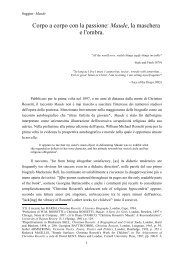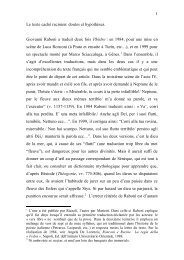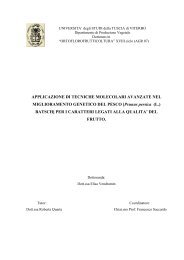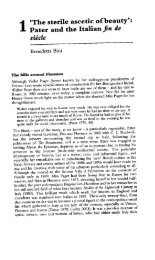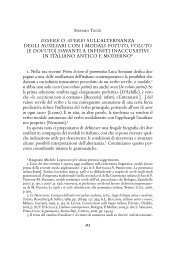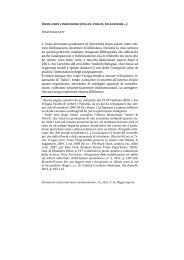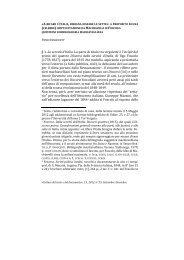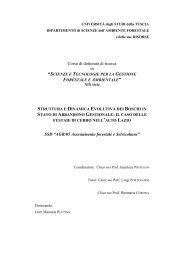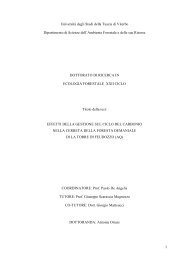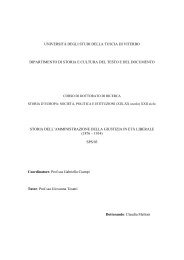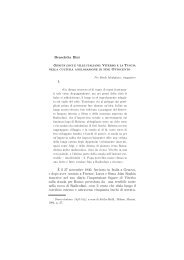drivers of soil respiration of root and microbial ... - Unitus DSpace
drivers of soil respiration of root and microbial ... - Unitus DSpace
drivers of soil respiration of root and microbial ... - Unitus DSpace
You also want an ePaper? Increase the reach of your titles
YUMPU automatically turns print PDFs into web optimized ePapers that Google loves.
(C0k) was negatively affected by the treatment indicating a different quality or different sources <strong>of</strong><br />
decomposing substrates with respect to UM <strong>soil</strong>s (Riffaldi et al., 1996).<br />
All these evidences support the hypothesis that microorganisms decreased their<br />
mineralization activity in MG <strong>soil</strong>s as other easily available energy sources were present.<br />
It is widely documented that the <strong>soil</strong> metabolic quotient (qCO2) is elevated when the <strong>soil</strong><br />
<strong>microbial</strong> biomass is operating inefficiently <strong>and</strong> is diverting a high proportion <strong>of</strong> C to maintenance<br />
requirements than biosynthesis (Anderson <strong>and</strong> Domsch, 1985).<br />
In our results qCO2 <strong>and</strong> <strong>soil</strong> enzymatic activity were significantly lower in MG plots <strong>and</strong><br />
suggested that the increase <strong>of</strong> easily available C in the rhizosphere <strong>of</strong> defoliated plants, resulting<br />
from a short-term flux <strong>of</strong> photoassimilate C below-ground, decreased the maintenance energy<br />
requirements <strong>and</strong> shifted the energy from maintenance to biosynthesis processes as the increase <strong>of</strong><br />
qmic also demonstrated (Bardgett et al., 1998; Holl<strong>and</strong> et al., 1996; Dilly, 2005). According to<br />
Schjonning et al. (2002) the decrease in qCO2 <strong>and</strong> specific enzyme activity indicates: a) a more<br />
efficient <strong>microbial</strong> community <strong>and</strong> b) a better use <strong>of</strong> the available organic substrates. Higher C use<br />
efficiency under defoliation was also reported by Guitian <strong>and</strong> Bardgett (2000) <strong>and</strong> Uhlirova et al.<br />
(2005).<br />
In our study almost all enzymes, involved in the cycling <strong>of</strong> S, P <strong>and</strong> C have demonstrated to<br />
be valid indicators <strong>of</strong> changes under management practices <strong>and</strong> have diminished its activity in<br />
managed <strong>soil</strong>. Only ß-cellobiohydrolase <strong>and</strong> arylsulphatase didn’ t show a significant decrease in<br />
MG plots, even so the negative trend for these enzymes was also observed. More likely that<br />
enhanced <strong>root</strong> exudation, leading to a larger supply <strong>of</strong> easily available C <strong>and</strong> energy sources to<br />
<strong>microbial</strong> communities resulted in general suppression <strong>of</strong> decomposition activities just after the<br />
mowing procedure. A significant relationship between SEI <strong>and</strong> qCO2 (Fig.14b) could be used as an<br />
extra prove <strong>of</strong> the bacterial community “ relax” in terms <strong>of</strong> C gaining in that period. N-acetyl-ß-<br />
glucosaminidase <strong>and</strong> arylsulphatase are also considered as indirect indicators <strong>of</strong> the presence <strong>of</strong> the<br />
fungal biomass because sulphate esters (substrates <strong>of</strong> arylsulphatase) <strong>and</strong> chitin are major<br />
components in fungal cells (B<strong>and</strong>ick <strong>and</strong> Dick, 1999). These could suggest a presence <strong>of</strong> a more<br />
efficient <strong>microbial</strong> community in the managed plots.<br />
The enhanced N mineralization activity just after the mowing <strong>and</strong> increase in the activity <strong>of</strong><br />
leucine amino-peptidase (involved in the N cycling) suggest that in grassl<strong>and</strong> community the<br />
defoliation practise stimulated the flow <strong>of</strong> C to <strong>root</strong>s <strong>and</strong> into the <strong>soil</strong>, increased the size <strong>of</strong><br />
<strong>microbial</strong> community, which in turn stimulated potential net N mineralization rates. Herbivores for<br />
example <strong>of</strong>ten enhance <strong>soil</strong> N cycling (McNaughton et al., 1997) which can result in the improved<br />
N availability to plants. In particular key <strong>microbial</strong>ly mediated processes involved in <strong>soil</strong> N cycling<br />
(nitrification, denitrification <strong>and</strong> N2-fixation) that largely control the balance the forms <strong>of</strong> <strong>soil</strong><br />
113




